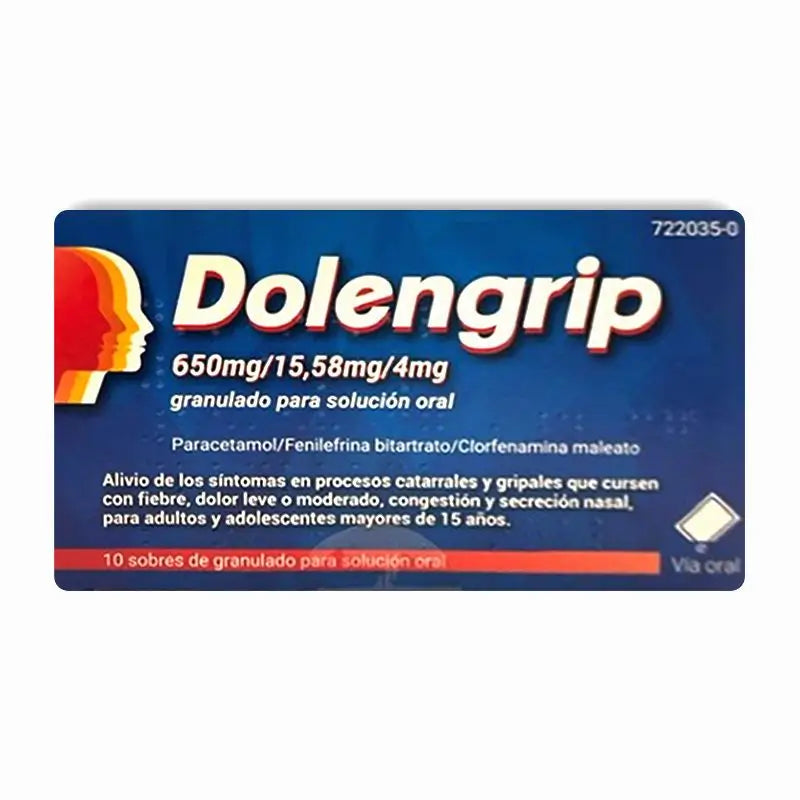What is dolengrip and what is it used for?
It is a triple medicine made up of Paracetamol is an analgesic that reduces pain and fever.
Chlorphenamine is an antihistamine that relieves runny nose.
Phenylephrine is a sympathomimetic that reduces nasal congestion.
It is indicated in adults and adolescents over 15 years of age for the relief of symptoms of colds and flus with fever or mild to moderate pain, congestion and runny nose.
Who it is for
Adults over 15 years of age


Composition of Dolengrip 650 mg/15.58 mg/4 mg granulate .
Composition of Dolengrip 650 mg/15.58 mg/4 mg granulate for oral solution
Each sachet contains:
As active ingredients: 650 mg paracetamol, 15.58 mg phenylephrine bitartrate (equivalent to 8.21 mg phenylephrine) and 4 mg chlorphenamine maleate (equivalent to 2.8 mg chlorphenamine).
The other ingredients (excipients) are: mannitol (E-421), saccharin sodium, colloidal anhydrous silica, orange flavouring (containing maltodextrin, which is a maize starch derivative) and povidone.
Adults and adolescents over 15 years of age: 1 sachet every 6-8 hours as needed (3 or 4 sachets per day). Do not take more than 3g of paracetamol (4 sachets) every 24 hours.
Patients with renal insufficiency: This medicine cannot be administered to these patients, because it contains 650 mg of paracetamol and its pharmaceutical form is granulated. As the maximum dose per dose for these patients is 500 mg, the contents of the sachet cannot be divided to achieve the appropriate dose.
Patients with hepatic insufficiency: in case of hepatic insufficiency or Gilbert's syndrome, do not exceed 3 sachets in 24 hours and the minimum interval between doses is 8 hours.
Read the package leaflet included with this medicine carefully. If you have any questions, you can consult our team of expert pharmacists.
Contraindications
Do not take this medicine if :
If you are allergic to the active substances or to any of the other ingredients of this medicinal product (listed in section 6).
If you suffer from high blood pressure.
If you suffer from hyperthyroidism.
If you suffer from diabetes mellitus.
If you suffer from tachycardia (rapid heartbeat).
If you are being treated with a monoamine oxidase inhibitor (MAOI) medicine (such as some antidepressant medicines, or medicines to treat Parkinson's disease).
If you are being treated with sympathomimetic medicines (medicines used to treat asthma, or medicines to speed up your heart rate).
If you are being treated with beta-blocker medicines (medicines for heart or artery diseases) (see: Other medicines and Dolengrip 650 mg/15.58 mg/4 mg granules for oral solution).
If you have glaucoma (raised eye pressure).
If you have severe heart or artery disease (such as coronary heart disease or angina pectoris).
If you have severe liver or kidney disease.
Pregnancy, lactation and fertility are not recommended, consult your doctor or pharmacist.
Side effects
The most common side effects that may occur are: Slight drowsiness, dizziness, muscle weakness: these side effects may disappear after 2-3 days of treatment. Difficulty in facial movements, clumsiness, tremor, alterations in sensations and tingling, dry mouth, loss of appetite, alterations in taste or smell, gastrointestinal discomfort (which may be reduced if the medicine is administered with food), nausea, vomiting, vomiting, vomiting, nausea and vomiting.vomiting, diarrhoea, constipation, stomach pain, urinary retention, dryness of the nose and throat, thickening of mucus, sweating, blurred vision or other visual disturbances.
Adverse effects that may occur infrequently (rare) are: Malaise, low blood pressure (hypotension), and increased blood transaminase levels. Myocardial infarction, ventricular arrhythmia (irregular heartbeat), pulmonary oedema (increased volume of fluid in the lungs) and cerebral haemorrhage (at high doses or in sensitive patients).
Nervous excitement (usually at high doses, and more common in the elderly and children), which may include symptoms such as restlessness, insomnia, nervousness and even convulsions. Other adverse effects that may occur infrequently include: chest tightness, lung sounds, fast or irregular heartbeat (usually with overdose), liver disorders (which may present with stomach or belly pain, dark urine or other symptoms), allergic reaction, andsymptoms), allergic reaction, severe hypersensitivity reactions (coughing, difficulty swallowing, rapid heartbeat, itching, swelling of eyelids or around the eyes, face, tongue, difficulty breathing, etc.), photosensitivity (sensitisation of the eyes, face, tongue, etc.), photosensitisation (sensitisation of the skin to the sun).), photosensitivity (sensitisation to sunlight), cross-sensitivity (allergy) to chlorphenamine-related medicines. Blood disorders (changes in blood cell formula, such as agranulocytosis, leucopenia, aplastic anaemia, thrombocytopenia) with symptoms such as bleeding, etc.).Symptoms such as unusual bleeding, sore throat or tiredness; low or high blood pressure, oedema (swelling), ear changes, impotence, menstrual disturbances.
Side effects that may occur very infrequently (very rare) are: Kidney disease, cloudy urine, allergic dermatitis (skin rash), jaundice (yellowing of the skin), blood disorders (neutropenia, haemolytic anaemia) and hypoglycaemia (low blood sugar).
Paracetamol can damage the liver when taken in high doses or in prolonged treatment.
Skin reactions have been reported very rarely.
Adverse effects, the frequency of occurrence of which is not known, are: Anxiety, irritability, weakness, increased blood pressure (hypertension, usually with high doses and in sensitive patients), headache (with high doses and may be a symptom of hypertension), very fast heartbeat (with high doses and may be a symptom of hypertension), high blood pressure (hypertension, usually with high doses and in sensitive patients), high blood pressure (hypertension).(severe bradycardia), reduction in the calibre of blood vessels (peripheral vasoconstriction), reduction in the output of the heart (peripheral vasoconstriction), reduced blood flow to the heart and heart failure (peripheral vasoconstriction).(peripheral vasoconstriction), reduced heart performance, especially in the elderly and in patients with poor cerebral or coronary circulation, possible development or aggravation of heart disease, urinary retention, pallor, bristly hair, high blood sugar (hyperglycaemia), high blood sugar (hyperglycaemia), high blood sugar (hyperglycaemia).blood sugar (hyperglycaemia), low blood potassium, metabolic acidosis (disturbance of metabolism), coldness in the extremities (legs or arms), flushing, feeling faint (hypotension). High doses may cause: vomiting, palpitations, psychotic states with hallucinations; prolonged use may cause decreased blood volume.